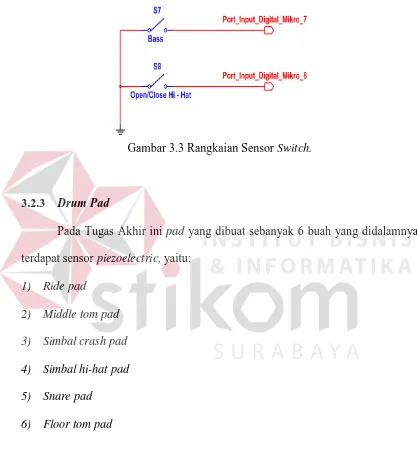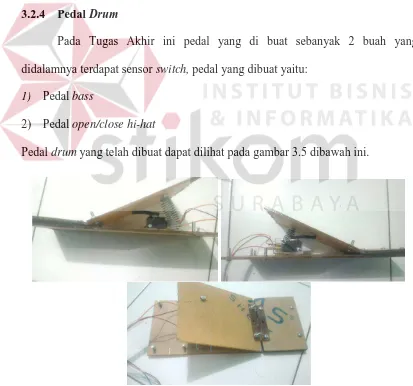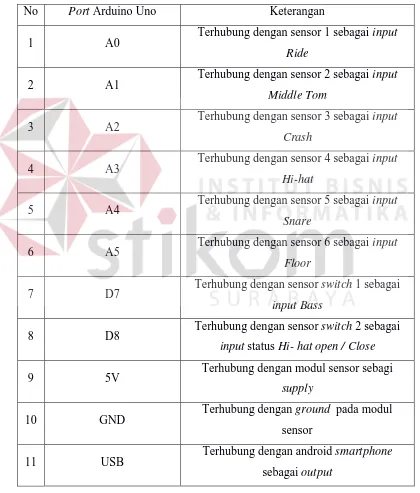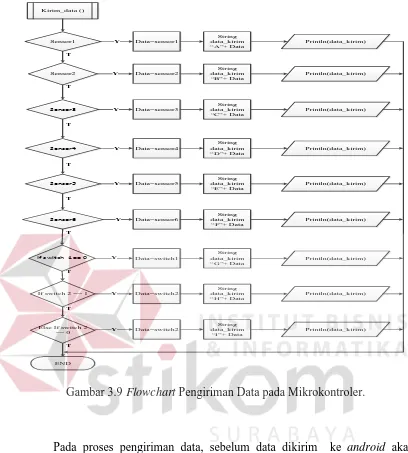Informasi Dokumen
- Penulis:
- Mambaul Ulum
- Sekolah: Institut Bisnis Dan Informatika Stikom Surabaya
- Mata Pelajaran: S1 Sistem Komputer
- Topik: Rancang Bangun Drum Kit Elektrik Berbasis Mikrokontroler Dan Android Smartphone
- Tipe: tugas akhir
- Tahun: 2016
- Kota: Surabaya
Ringkasan Dokumen
I. PENDAHULUAN
This section introduces the background of the study, emphasizing the rapid technological advancements in music instruments, particularly the transition from traditional acoustic drums to digital drum kits. It highlights the limitations of conventional drum kits in terms of mobility and space, leading to the necessity for a portable electric drum kit that integrates with microcontrollers and smartphones. The section articulates the research problem, objectives, and the significance of developing a drum kit that enhances both mobility and sound quality, ultimately aligning with educational goals in technology and music integration.
1.1 Latar Belakang Masalah
The background discusses the evolution of music technology, particularly in drumming. It notes the challenges faced by musicians using traditional drum kits, such as space requirements and portability issues. The emergence of electric drum kits is presented as a solution, with a focus on the role of microcontrollers in enhancing mobility and sound output. This section sets the stage for the research by establishing the need for innovative solutions in musical instrument design.
1.2 Rumusan Masalah
This subsection outlines the specific research questions guiding the study. It focuses on the design of an electric drum kit using vibration sensors and microcontrollers, and the development of an Android application to control sound output based on the intensity of drum hits. These questions aim to address the technical challenges in creating a responsive and effective electric drum kit.
1.3 Batasan Masalah
The limitations of the study are clearly defined to maintain focus and manageability. It specifies the components of the electric drum kit, the communication methods used, and the compatibility requirements for the Android smartphone. By establishing these boundaries, the research can concentrate on specific technical aspects without deviating into broader topics.
1.4 Tujuan
The objectives of the research are articulated, aiming to design a functional electric drum kit and an accompanying Android application. These objectives are aligned with educational outcomes, promoting hands-on learning in electronics, programming, and music technology. The goals emphasize practical applications of theoretical knowledge in a real-world context.
1.5 Sistematika Penulisan
This subsection provides an overview of the document's structure, outlining the contents of each chapter. It serves as a roadmap for readers, facilitating understanding of how the research is organized and the logical flow of information. This systematic approach enhances the educational value by making the material more accessible.
II. LANDASAN TEORI
This section delves into the theoretical foundations that support the research, covering key concepts related to electric drums, piezoelectric sensors, microcontrollers, and software development environments. Each topic is explored in detail, providing a robust framework for understanding the technical aspects of the project and their relevance to both music and technology education.
2.1 Drum Elektrik
The concept of electric drums is introduced, describing their structure and function compared to traditional drums. It explains how electric drums use sensors to capture vibrations and convert them into digital signals, which can then be processed to produce sound. This section emphasizes the educational implications of understanding modern musical instruments and their technology.
2.2 Piezoelectric
This subsection explains the piezoelectric effect and its application in sensor technology. It discusses how piezoelectric sensors convert mechanical pressure into electrical signals, making them ideal for use in electric drums. Understanding these principles is crucial for students in fields like electronics and sound engineering, linking theoretical knowledge to practical applications.
2.3 Mikrokontroler
The role of microcontrollers in processing sensor data is explored, highlighting their importance in modern electronic devices. This section discusses the architecture of microcontrollers, their functionalities, and their applications in controlling various electronic systems, reinforcing concepts in computer science and engineering education.
2.4 Arduino
Arduino is presented as an accessible platform for prototyping electronic projects. The section covers its components, programming environment, and advantages for beginners and experts alike. This knowledge is essential for students learning about embedded systems and encourages creative problem-solving in technology.
2.5 Software Aurduino IDE
The Arduino IDE is discussed as a tool for developing software for microcontrollers. This subsection explains its features, including code editing, compiling, and uploading processes. Familiarity with this software is crucial for students in programming and electronics courses, enhancing their technical skills.
2.6 Android
This part introduces the Android operating system, its architecture, and its relevance in mobile application development. It emphasizes the role of Android in creating user-friendly applications for controlling electronic devices, linking mobile technology with education in software development.
2.7 Basic4Android
Basic4Android is presented as a tool for rapid application development on Android. This section discusses its features and benefits for developing applications without extensive programming knowledge. This knowledge empowers students to create applications that interface with hardware, bridging the gap between software and hardware.
III. METODE PENELITIAN
This section outlines the research methodology employed in the study, detailing the design and development processes for both hardware and software components of the electric drum kit. It describes the systematic approach taken to ensure that the final product meets the educational objectives set forth in the introduction.
3.1 Metode Penelitian
The research methodology is detailed, describing the phases of concept development, literature review, and system design. This structured approach ensures that the research is grounded in existing knowledge while fostering innovation in the design of the electric drum kit.
3.2 Perancangan Perangkat Keras (Hardware)
This subsection focuses on the hardware design of the electric drum kit, discussing the integration of sensors and microcontrollers. It provides insights into the technical specifications and design considerations, which are essential for students learning about electronics and engineering design.
3.2.1 Perancangan Sensor Piezoelectric
The design of piezoelectric sensors is elaborated, explaining how they are implemented in the drum pads to detect hits. This practical application of sensor technology is crucial for students in understanding real-world applications of theoretical concepts.
3.2.2 Perancangan Sensor Switch
This subsection describes the design of switch sensors for the drum pedals. It explains how these sensors function and their role in the overall system, reinforcing the importance of understanding different types of sensors in electronic systems.
3.2.3 Drum Pad
The design and construction of the drum pads are discussed, highlighting the integration of sensors within the pads. This hands-on experience is valuable for students, providing practical skills in building electronic instruments.
3.2.4 Pedal Drum
This part focuses on the design of the drum pedals, detailing how they are equipped with sensors for functionality. Understanding pedal design is important for students interested in mechanical and electronic integration in musical instruments.
3.2.5 Koneksi Port pada Modul Mikrokontroler Arduino Uno
The connections on the Arduino Uno module are outlined, explaining how various components interface with the microcontroller. This technical knowledge is essential for students learning about circuit design and microcontroller applications.
3.3 Perancangan Perangkat Lunak (Software)
The software design process is detailed, focusing on the programming aspects necessary for the drum kit's functionality. This section emphasizes the significance of software development in electronics, reinforcing the importance of coding skills for students.
3.3.1 Perancangan Program pada Modul Mikrokontroler Arduino
This subsection discusses the programming of the Arduino module, including the flowchart that guides the logic of the software. Understanding programming logic is crucial for students in computer science and engineering disciplines.
3.3.2 Pembacaan Data Sensor Piezoelectric
The process of reading data from piezoelectric sensors is explained, detailing how the microcontroller processes this information. This technical understanding is vital for students working with sensor data in electronic projects.
3.3.3 Pengiriman Data pada Modul Mikrokontroler Arduino
This subsection describes the data transmission process from the microcontroller to the Android device, emphasizing the importance of communication protocols in electronic systems. This knowledge is essential for students studying data communication.
3.3.4 Perancangan Aplikasi pada Android Smartphone
The design of the Android application is discussed, focusing on how it interacts with the drum kit. This practical application of mobile development is relevant for students interested in software engineering and mobile technology.
3.3.5 Deteksi Modul Arduino pada Android Smartphone
This part explains how the Android application detects the connected Arduino module, highlighting the integration of hardware and software. This knowledge is crucial for students learning about device connectivity.
3.3.6 Penerimaan Data pada Aplikasi Android Smartphone
The process of receiving data in the Android application is detailed, explaining how the application processes incoming data from the drum kit. This understanding of data handling is essential for students in software development.
IV. HASIL PENGUJIAN DAN EVALUASI SISTEM
This section presents the results of the testing and evaluation of the electric drum kit system, discussing the performance of both hardware and software components. It provides insights into the effectiveness of the design and identifies areas for improvement, which is valuable for students in engineering and technology fields.
4.1 Pengujian Pembacaan Sensor Piezoelectric
The testing of piezoelectric sensor readings is detailed, including objectives, tools used, and procedures followed. This practical evaluation helps students understand the importance of testing and validation in engineering projects.
4.2 Pengujian Pembacaan Sensor Switch
This subsection discusses the testing of switch sensors, outlining the goals and methods used. The importance of reliable sensor performance is emphasized, providing insights into quality assurance in electronic design.
4.3 Pengujian Pengiriman Data Mikrokontroler Arduino
The evaluation of data transmission from the microcontroller is presented, highlighting the effectiveness of communication between components. This understanding is crucial for students in learning about system integration.
4.4 Pengujian Aplikasi pada Android Smartphone
The testing of the Android application is discussed, focusing on its functionality and user interface. This evaluation provides practical insights into software testing and user experience design, which are important for software developers.
4.5 Pengujian Keseluruhan Sistem
This part summarizes the overall system testing, discussing the performance and reliability of the electric drum kit as a whole. It reinforces the importance of comprehensive testing in engineering projects, encouraging students to adopt thorough evaluation practices.
V. PENUTUP
The conclusion section summarizes the findings of the research, reiterating the significance of the developed electric drum kit and its educational applications. It provides recommendations for future work, emphasizing the importance of continuous improvement in technology and education.
5.1 Kesimpulan
This subsection presents the main conclusions drawn from the research, emphasizing the successful integration of microcontrollers and mobile technology in creating a portable electric drum kit. It highlights the educational value of the project, showcasing how it meets the objectives outlined in the introduction.
5.2 Saran
Recommendations for future research and development are provided, suggesting areas for improvement and further exploration. This forward-looking perspective encourages students to think critically about ongoing advancements in technology and their implications for education and practice.
Referensi Dokumen
- Arduino Board Uno ( Arduino )
- Arduino Language Reference ( Arduino )
- B4A Beginner's Guide edition 3.1 ( Christl, K. & Uziel, E. )
- Pengisian dan Pengatur Tekanan Ban Sepeda Motor Berbasis Mikrokontroler ATMega 8535 Dengan Tampilan Liquid Crystal Display (LCD) ( Desirianti, E. R. )
- Pengenalan Android ( Djuandi, F. )
- Pengukuran Kinerja Goodreads Application Programming Interface (API) Pada Aplikasi Mobile Android ( Ichwan, M. & Hakiky, F. )
- Analisi dan Perancangan Perangkat Keras Midi Drum Kit Elektrik Berbasis Mikrokontroller Arduino ( Kurniawan, W. & Santoso, J. D. )
- yamaha DTX400 Series ( Yamahadtx )
- Optimasi Purwarupa Kendali Virtual Instrumen Musik Drum Berbasis Sensor Akselerometer dan LDR ( Yuniar, A. & Prastowo, B. N. )









